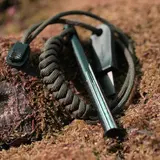

Steel Ferro Rod Firestarter
A Spark of Survival: A Comprehensive Review of Steel Ferro Rod Fire Starters
Steel ferro rod fire starters have become a staple in the gear of outdoor enthusiasts and survivalists alike. These unassuming rods, often paired with a striker, offer a reliable and efficient way to ignite a fire in virtually any weather condition. Let's delve into the intricacies of these devices and explore why they've earned their reputation as essential survival tools.
The Science Behind the Spark
A ferro rod is typically made of a high-carbon steel alloy, often containing elements like cerium or lanthanum. When struck against a hard, sharp object (the striker), the friction creates intense heat, causing tiny particles of the alloy to ignite and produce a shower of sparks. These sparks are hot enough to ignite tinder, which is a highly flammable material like dry bark, cotton balls, or char cloth.
Benefits of Steel Ferro Rod Fire Starters
- Reliability: One of the most significant advantages of ferro rods is their reliability. Unlike matches or lighters, they are not affected by wind, rain, or humidity. This makes them ideal for outdoor activities in challenging environments.
- Durability: Well-made ferro rods are incredibly durable and can last for years with proper care. They are resistant to corrosion and can withstand harsh conditions without losing their effectiveness.
- Lightweight and Portable: Ferro rods are compact and lightweight, making them easy to carry in a backpack or survival kit. Their small size and portability make them a valuable asset for hikers, campers, and preppers.
- Versatility: Ferro rods can be used with a variety of tinder materials, allowing for flexibility in different situations. Whether you have dry leaves, bark, or a fire starter kit, you can ignite a fire using a ferro rod.
- 5. Long-Lasting: A quality ferro rod can produce thousands of sparks, providing a reliable source of ignition for many years. This makes them a cost-effective investment for outdoor enthusiasts.
Considerations and Tips for Fire Steels
Striker: The striker is an essential component of a ferro rod fire starter. A good striker should be hard and sharp to produce the necessary friction. Common materials for strikers include flint, ceramic, or hardened steel.
Tinder: Choosing the right tinder is crucial for successful fire starting. Look for dry, fibrous materials that will ignite easily from the sparks. Char cloth is a popular choice due to its high flammability and ability to stay lit even in windy conditions.
Safety: Always use caution when using a ferro rod, as the sparks can be hot and potentially cause burns. Keep the ferro rod away from flammable materials and avoid striking it towards your face or body.
Maintenance: While ferro rods are generally low-maintenance, it's a good idea to clean them occasionally to remove any debris or residue that may interfere with their performance.
Conclusions about Ferro Rods
Steel ferro rod fire starters are indispensable tools for anyone who spends time outdoors. Their reliability, durability, and versatility make them a valuable asset for survivalists, hikers, campers, and preppers. By understanding the science behind ferro rods and following a few simple tips, you can confidently use this tool to ignite a fire in any situation.